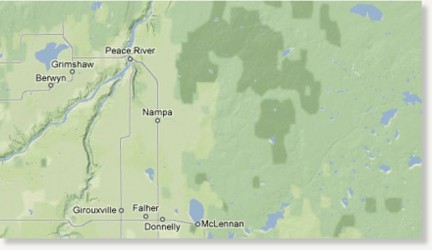Article Origin
Volume
Issue
Year
The closure of Little Buffalo School after staff and students complained of headaches and nausea, and the fact that the largest oil spill in Alberta in three decades occurred only 20 km from the Lubicon Lake First Nations community on April 29, seems to be nothing more than coincidence.
“There appears to be no connection,” said Garrett Tomlinson, spokesman for Lubicon Lake First Nation.
“The (Energy Resources Conservation Board) and the Department of Health say there’s no danger in levels of hydrocarbons or other substances in the air.”
Alberta Environment and provincial government departments are monitoring the air following a rupture of Rainbow Pipeline and the release of 28,000 barrels of crude oil into the land and a nearby pond. Monitoring will continue at the rupture site, as well as at the school for the next several weeks.
“Our concern, first and foremost, is the health and safety (of our people). Chief (Bernard Ominayak) and council are taking precautions,” said Tomlinson.
A medical professional station has been set up at the Lubicon office to allow for immediate emergency care.
Tomlinson noted that the ERCB was monitoring the condition of Little Buffalo School, located in Cadotte Lake, with the help of the Northland School Division.
“We don’t want the kids going back to school and getting sick,” said Tomlinson. “We don’t want one problem masking another.”
The school reopened on May 10.
Another concern voiced by chief and council was the lack of immediate communication from Plains Midstream Canada, which operates the pipeline. The Lubicon Lake First Nation was notified by the ERCB of the leak hours after it had occurred.
“The chief has indicated that he would have preferred the officials from Plains Midstream had spoken to us a lot sooner,” said Tomlinson. “He’d also prefer that (Plains Midstream) be the ones to communicate with us about the break.”
The spill occurred in the early morning hours. At 2:30 a.m. Plains Midstream’s control centre detected a drop in pressure and the automatic valves shut off a 72-km section of the Rainbow Pipeline.
At first light, Plains Midstream sent a helicopter crew up to survey the pipeline, said Stephen Bart, vice-president of operations for Plains Midstream Canada. The leak was identified at mile post 188.
“At that point we triggered our emergency response plan, which, amongst other things, calls for notification to a number of regulators and local communities. So First Nations communities would have been called within hours of the incident,” said Bart.
Since then communication has improved, said Tomlinson. Bart has been at the Lubicon office meeting with band officials and Lubicon personnel have been at the spill site along with Environment Minister Rob Renner, Solicitor General and Public Security Minister and MLA for Peace River Frank Oberle, and Lesser Slave Lake MLA Pearl Calahasen.
“We’re having input in the decisions and we’re satisfied at this point with the communication process,” said Tomlinson.
The oil is largely contained on the 30-metre-wide pipeline right-of-way, although some escaped into a nearby wetland. A beaver dam contained the spill to a pond. The nearest residence is seven kilometres away.
Approximately 300 response personnel have been on site working on containment, oil recovery, line repair and site remediation. Containment, which has been achieved, included using vacuum trucks to remove oil from the ground and skimmer machines to remove oil from the pond.
Duck lines across the pond, scare cannons, and a six-foot high fence bordering the entire site have been employed to keep wildlife away. To date, seven beaver, 19 ducks, six migratory birds, and two frogs have died due to contamination.
Full clean-up and reclamation of the site is a moving target.
“Obviously every day we get more information about our productivity and success of the clean-up and we’re able to revise those (estimates),” said Bart.
It is thought the clean-up could take about six months. Bart said his company will be there as long as it takes to “properly remediate it.” Plains Midstream is also covering the cost.
Tomlinson said the Lubicon will be present every step of the way in the reclamation process.
“The Lubicon will take an active role because our quality of standard will be met best if we’re the ones standing there doing it,” said Tomlinson.
Repair work on the damaged portion of the pipeline has been completed, said Bart, and Plains Midstream has applied to the ERCB to reactivate the line.
However, Davis Sheremata, spokesman with ERCB, said an investigation will be undertaken to ensure the rupture is not a systemic issue. Initial indication is that the portion of the pipeline broke because of a badly fitting weld and inadequate in-fill that followed servicing of the pipeline in 2010. Most of the pipeline is 44 years old, but some portions have been upgraded.
“We need immediate action and we are also calling for an independent investigation into this incident, with the goal of establishing urgent measures and regulation of oil spill incidents,” said National Chief Shawn Atleo of the Assembly of First Nations in a prepared statement. “This is a clear demonstration as to why we need plans in place to deal with future disasters.”
The Rainbow system consists of a 20-inch to 24-inch pipeline spanning 480 miles, traveling from Zama, Alta, to Edmonton. In 2010, the pipeline transported approximately 187,000 barrels per day.
This is the second major spill from the Rainbow line. In late 2006, 7,500 barrels leaked from the pipe.
- 8593 views

